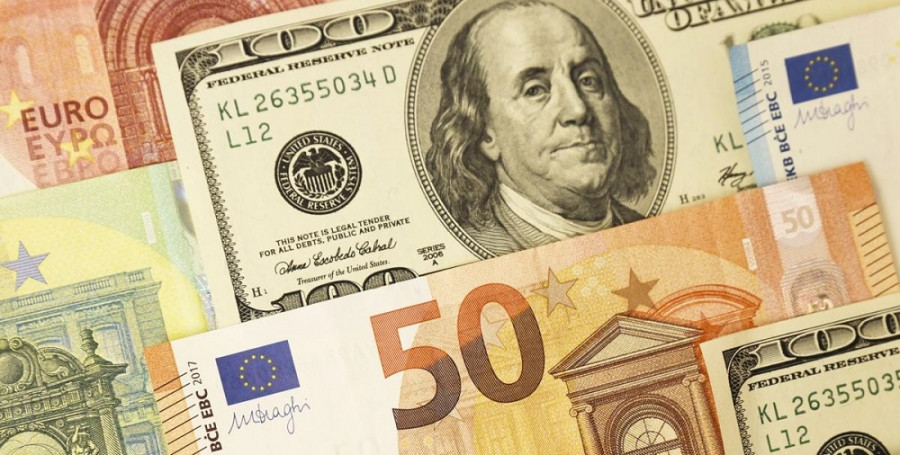
The Euro-Dollar pair continues to trade flat, within the 8-figure range. On Tuesday, EUR/USD buyers updated the local high at 1.0917 but could not hold their positions, having sellers regain the initiative. During the American trading session, they pushed through the support level at 1.0850 (the upper boundary of the Kumo cloud on the daily chart) and even reached 1.0820. However, they did not dare to go further – they locked in profits and ended the day at 1.0853.
On Wednesday, buyers regained the initiative. Reacting to the published PMIs, the pair has again moved towards the 9-figure boundaries. However, in the current fundamental conditions, it's not appropriate to talk about a stable upward or downward movement: important releases are expected on Thursday and Friday, which could determine the direction of the American currency, strengthening or weakening the positions of the dollar bulls (the U.S. GDP growth report and the core PCE index). Moreover, the European Central Bank will announce the results of its January meeting on Thursday. This event is also significant, even though the formal outcomes of this meeting are predetermined.

But let's return to the PMIs. The European currency positively reacted to the published figures, although, in reality, this report is quite contradictory. Firstly, all indicators remain in the contraction zone, i.e., below the key 50-point mark. Secondly, not all components of the release came out in the "green zone."
EUR/USD buyers positively responded to the increase in the business activity index in Germany's manufacturing sector. This indicator rose to 45.4, with a forecast of an increase to 43.7. The index shows a consistent upward trend for the sixth month in a row, and the January result is the best since February 2023. This is certainly a reason for a corresponding reaction. However, traders ignored the fact that the German business activity index in the service sector declined sharply, landing in the "red zone." Instead of increasing to 49.5 points, the figure came out at 47.6, the worst result since August last year.
In France, a similar situation unfolded: the business activity index in the manufacturing sector rose to 43.2 (with a forecast of 42.2), while in the service sector, it fell to 45.0, with a forecast of an increase to 46.1 (the worst result since September 2023). Overall, the Eurozone shows similar trends: in the manufacturing sector, the index rose to 46.6 (the best result since March last year), while in the service sector, it fell to 48.4 points, with a forecast increase to 49.1.
In other words, activity in the service sector is not only consistently declining but is also accelerating its fall. In the manufacturing sector, which remains in the contraction territory, the decline has somewhat softened.
In anticipation of the results of the ECB's January meeting to be released Thursday, EUR/USD traders focused their attention on the positive dynamics of the German (and European) manufacturing PMI, but at the same time, they ignored the decline in the service sector indicators. This suggests that the current rise in EUR/USD is more of an emotional nature and cannot inherently be stable.
It should also be noted that the pair's rise is driven by the decline in the U.S. dollar index, against the backdrop of statements by the former head of the St. Louis Fed, James Bullard, who admitted a possible rate cut even before inflation reaches its target threshold of 2.0%. Bullard said the Federal Reserve might start easing monetary policy as early as the March meeting. It's important to note that the market's dovish expectations have significantly weakened lately – if at the end of December, the probability of a rate cut in March was estimated at almost 80%, as of writing, the market assesses this probability at 50% (according to the CME FedWatch Tool data). Therefore, Bullard's assumption exerted certain pressure on the dollar.
Tuesday's Richmond Fed manufacturing activity index also exerted background pressure on the greenback. The Richmond Fed's region includes the District of Columbia, Maryland, North Carolina, South Carolina, Virginia, and most of West Virginia. The manufacturing activity index has shown a downward trend for the fourth consecutive month (and has been below zero since November). In January, it plummeted to -16 (with a forecasted decline to -7), the lowest value of the index since February last year.
Overall, the situation with the pair is quite contradictory. Traders impulsively react to the current news flow, but they are essentially marking time, circling within the 8-figure range (indecisive and fruitless 'flinching' around the 9-figure range doesn't count). Everyone is waiting for the main battle of the week, which will take place in the coming days. On Thursday, we will learn the outcomes of the ECB's January meeting and the dynamics of the growth of the American economy in the 4th quarter of 2023, and on Friday, December's core PCE index value. Therefore, ahead of these events, it is prudent to take a wait-and-see approach to the pair – both buying and selling EUR/USD seems risky and unreliable.